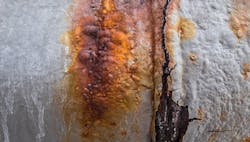Corrosion: Don’t Put Peddle To The Metal
Corrosion concerns often prompt thoughts of using stainless steel. However, even when economics permit, its application requires care. Stainless steel isn’t a panacea.
For instance, a chlorine release from a brick-lined carbon-steel vessel spurred discussion on how to avoid a recurrence. The incident investigation showed that acid had worm-holed into the brick and attacked the wall. Some less-experienced engineers suggested switching to a tank made of some exotic grade of stainless steel or even cladding. A better option was to improve inspection of bricks, mortar and the bricking process.
An abrasive mix of paraformaldehyde, tetramethylpentane and who knows what else carved grooves into Type-304 stainless steel in less than a dozen years. Carbon steel, while about 10% stronger than stainless, wasn’t an option because it would discolor the product. So, I recommended going with thicker pipe (Schedule 40 instead of Schedule 10), thereby doubling the life of the pipe.
In another case, a Type-304 boiler feedwater line coming out of a deaeration tank gradually thinned out and finally failed. Makeup to the tank is river water — heavily dosed with chlorine that’s often poorly controlled. An anti-oxidant protects the pipe. I don’t yet know whether the issue stems from over-dosing the anti-oxidant, the chlorine reacting with the anti-oxidant to produce HCl or something else. I do know a protective layer of chromium is why a stainless steel pipe doesn’t erode away, especially in de-ionized water. If erosion occurs in stainless steel, it’s because the chromium can’t re-oxidize; levels below 12% chromium provide no protection.
In another example, Type-304 vessels manufactured in Italy showed spider cracks and weld pits. Chlorine exposure in combination with high temperatures, widely varying pH and high salt concentrations contributed to shortened life. Because no records were translated for the tank fabrication process, it was suspected, without proof, that annealing and pickling treatments might have helped.
A common problem with stainless steel is people not respecting the difference between carbon steel and stainless either by welding one to the other or by using carbon steel bolts (generally a good idea) without isolating the contact with the stainless steel. I have seen this go so far as to prompt either the carbon steel fasteners (nuts, bolts, studs) to rust away, fail and cause the connection to leak, or create local corrosion at a flange that weakened the connection enough to leak. It’s important to remember that corrosion is like compound interest: a little every day eventually can add up to a lot.
[pullquote]
(Using stainless steel fasteners on carbon steel pressure vessels can raise issues, too. See: “Solve the Real Problem.”)
Then, there’s anaerobic attack by bacterial. This corrosion has something in common with the boiler feedwater problem: removal of the protective chromium oxide layer by depriving the exposed surface of renewing oxygen, thus allowing attack of the iron. Raising the pH out of the basic range or increasing the temperature are the best approaches for reducing bacteria attack.
Probably the most common corrosion in stainless steel is pitting at welds. When I worked at Anheuser-Busch, this stemmed from chlorine attack at temperatures above 105°F. Usually, sterilization requirements meant that we couldn’t avoid the high temperature, so we specified low-carbon stainless steel — as if this helped! Pitting is especially annoying in the food and pharmaceutical industries because it can result in rough surfaces that hide bacteria.
In tanks and static duty, pitting is easy to spot if monitored: the chromium disappears and the pit turns rusty or black. In pipelines or where erosion sweeps away the rust, detection is more difficult. Ultrasonic instruments can spot thinning — but only once the pitting is difficult to repair; the head of a hand-held ultrasonic gage is about 0.4 in., so I doubt if detection is possible. One precaution, which often is ignored, is to ensure welds in pipes and equipment are accessible to inspectors. Even more important is to perform inspections as often as required per ASME code — and more frequently, if required.
So, what can be done? Make sure the stainless steel is oxygenated to replenish the chromium layer. Watch the pH and temperature; thereby preserving an environment where the steel can survive. Most of all, be aware of process conditions.
DIRK WILLARD is a Chemical Processing Contributing Editor. You can email him at [email protected]
About the Author

Dirk Willard
Contributing Editor
DIRK WILLARD is a former ASBPE award-winning columnist for Chemical Processing's Field Notes column. During his 10+ years as a contributing editor for CP, he wrote hundreds of valuable and insightful pieces on design and operational issues. He retired in 2023.
